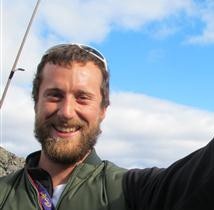C. Gabriel Creason

M. Sc. Thesis
(PDF - 23.8 Mb)
The eastern Canadian Arctic Rim (eCAR) is a rugged, high-relief landscape extending along the continental margin from northern Labrador to southeastern Ellesmere Island. While much of the relief along the eCAR may be related to rift-flank uplift and incision during and after rifting between Canada and Greenland, rock thermal histories derived from previous thermochronologic studies from the northern and southern regions of the eCAR, as well as in West Greenland, are incompatible with a single, representative exhumation history for the entire eCAR. Potential causes for the disparate histories include the existence of a crustal root under Labrador and multiple rifting events over the past 400 Ma. This study aims to characterize the long-term exhumation history of Hall Peninsula, Baffin Island, and, by linking together previous thermochronologic studies in the eCAR, test various models of tectonic and geomorphic evolution of southeastern Baffin Island. In total, 28 rock samples, collected along one vertical and two iso-elevation transects, were analyzed by low-temperature (U-Th-Sm)/He thermochronometry (26 apatite-He (AHe), 7 zircon-He (ZHe); 5 aliquots each) to help define the cooling history of the rocks on Hall Peninsula. Results from these samples reveal highly dispersed cooling ages, spanning 75–1078 Ma in the AHe data, and 326–1229 Ma in the ZHe data. Strong correlations between effective U concentration (eU = U + 0.235*Th + 0.005*Sm) and AHe and ZHe cooling age indicate that the cooling ages are heavily influenced by the effects of alpha-recoil damage. Thermal modeling of individual samples (using HeFTy) suggests a history of protracted, slow cooling across the entire Peninsula, with most cooling events initiating from middle Paleozoic. This is supported by the results of modeling with a 3D thermokinematic program (PECUBE) to determine the collective tT history of the rocks on Hall Peninsula. A series of tectonomorphic scenarios were simulated in PECUBE to test whether the spatial distribution of AHe ages could be explained through a simple (i.e., vertical) exhumation by erosional processes, or if it requires a more complex exhumational history (e.g., faulting). Despite the limitations of the highly dispersed data, the results from both the HeFTy and PECUBE models indicate that Hall Peninsula experienced extremely slow cooling (≤ 1 ºC/Ma) throughout the Phanerozoic. The models are consistent with a regional Carboniferous-Permian cooling event that may have triggered rapid cooling, followed by an extremely slow exhumation averaging less than 10 m/Ma. In contrast to the Greenland conjugate margin and Torngat Mountains to the south, it appears that Hall Peninsula did not experience rapid cooling during rifting between Baffin Island and Greenland.
Keywords: Hall Peninsula, Baffin Island, Exhumation history, Eastern Canadian Arctic Rim, (U-Th-Sm)/He thermochronology, thermal modeling, 3D thermokinematic modeling
Pages: 243
Supervisor: John Gosse



